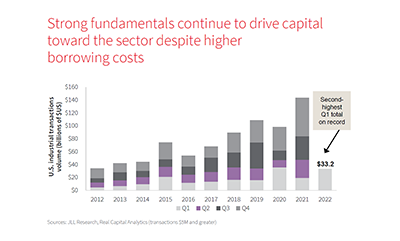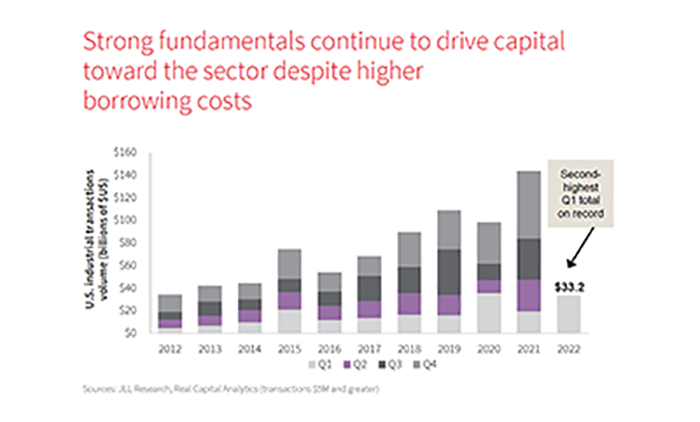
Industrial Fundamentals Break More Records

JLL, Chicago, reported the industrial sector vacancy rate fell for the sixth consecutive quarter in early 2022, from 3.8 percent to 3.4 percent.
Mehtab Randhawa, Senior Director with JLL, said the competitive environment has given industrial landlords the edge in the market and placed upward pressure on asking rents. She noted the average asking rent climbed to $7.62 per square foot, a 7 percent increase over the last quarter.

“This is the largest quarter-over-quarter increase since at least 2000,” Randhawa said. “Occupiers’ sticker shock is not limited to asking rents, though. Those looking to sign new leases in lowest vacancy markets are facing steeper annual rent escalations and minimal concessions. Companies with a business imperative to locate in these white-hot markets are willing to pay the price, while more location flexible occupiers are exploring their options in markets with cheaper rents, lower labor costs and more abundant new product.”
This trend is fueling a shift of demand to markets in the Southeast and South Central regions, Randhawa noted.
The JLL Industrial Outlook 1Q 2022 report called industrial demand strong across the country. Occupiers absorbed 110.8 million square feet in the first quarter. Though this represented a modest deceleration from the fourth quarter, it was a “remarkable showing” during what is typically the slowest time of year for move-ins, the report said.
“[The first quarter] ranks as the third-highest quarter for net absorption on record and the highest of any first quarter by a considerable margin,” JLL said. “Leasing activity ramped up in Q1, which suggests upcoming quarters may bring even greater occupancy gains.”
Developers delivered 90 million square feet of new inventory in the first quarter. “While strong by historical standards, especially for the first quarter, this influx of new space barely moved the needle on vacancy for most markets,” the report said. “Projects continue to be mired in delays due to materials and labor shortages, though volatility in material pricing has started to calm.”
JLL said the pandemic and growing e-commerce adoption accelerated demand for industrial real estate over the last two years. “While this created numerous opportunities for occupiers and investors, it also brought challenges as space became scarcer and rents increased rapidly,” the report said. “The massive construction pipeline signals significant supply growth on the horizon, but the pace of deliveries will likely continue to be hampered by material and labor shortages.”
